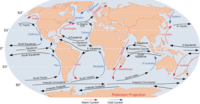
Photo from wikipedia
Low-resolution, complex general circulation models (GCMs) are valuable tools for studying the Earth system on multi-millennial timescales. However, slowly evolving salinity drifts can cause large shifts in climatic and oceanic… Click to show full abstract
Low-resolution, complex general circulation models (GCMs) are valuable tools for studying the Earth system on multi-millennial timescales. However, slowly evolving salinity drifts can cause large shifts in climatic and oceanic regimes over thousands of years. We test two different schemes for neutralising unforced salinity drifts in the FAMOUS GCM: surface flux correction and volumetric flux correction. Although both methods successfully maintain a steady global mean salinity, local drifts and subsequent feedbacks promote cooling (≈ 4 °C over 6000 years) and freshening (≈ 2 psu over 6000 years) in the North Atlantic Ocean, and gradual warming (≈ 0.2 °C per millennium) and salinification (≈ 0.15 psu per millennium) in the North Pacific Ocean. Changes in the surface density in these regions affect the meridional overturning circulation (MOC), such that, after several millennia, the Atlantic MOC (AMOC) is in a collapsed state, and there is a strong, deep Pacific MOC (PMOC). Furthermore, the AMOC exhibits a period of metastability, which is only identifiable with run lengths in excess of 1500 years. We also compare simulations with two different land surface schemes, demonstrating that small biases in the surface climate may cause regional salinity drifts and significant shifts in the MOC (weakening of the AMOC and the initiation then invigoration of PMOC), even when the global hydrological cycle has been forcibly closed. Although there is no specific precursor to the simulated AMOC collapse, the northwest North Pacific and northeast North Atlantic are important areas that should be closely monitored for trends arising from such biases.
Journal Title: Climate Dynamics
Year Published: 2018
Link to full text (if available)
Share on Social Media: Sign Up to like & get
recommendations!